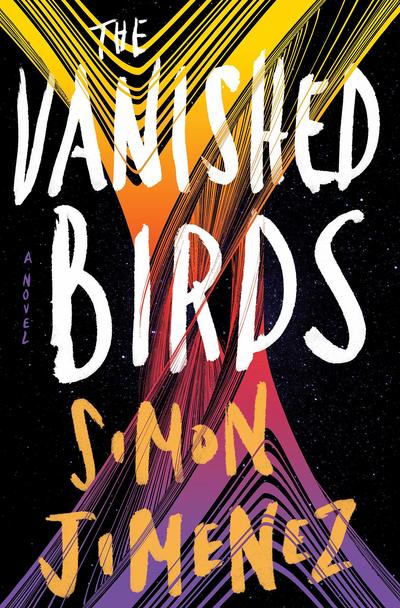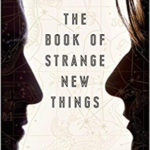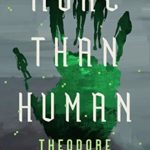Simon Jimenez‘ The Vanished Birds is an amazing novel that takes you from humble beginnings on an agrarian planet across thousand-year time spans, multiple worlds, journeys through folded space, then by instant travel into mysterious dimensions beyond time and normal reality into the depths of human connection. It offers powerful and lyrical testament to the sheer force of love and all its frustrations, disappointments, sacrifices, renewals and endless attempts to reconnect with those who have been lost.

I’ve never read anything like this first novel, one of the most intricate and deeply moving stories told on many levels through many perspectives. It sometimes seems so complicated that I feared the author could never pull everything together, but he does in a song-like ending that celebrates human connection and love in a way I’ve only encountered in a few great novels.
There is no lack of science fictional elements at the heart of the story, but they and the major characters are all introduced through slant perspectives. The story starts following a boy named Kaeda who is part of a farming family on a remote planet known as Umbai-V. Once every fifteen years a dozen space ships arrive to take away the harvest of a special bean the inhabitants spend their lives cultivating. We come to learn that this planet is a resource of the all-powerful Umbai corporation that governs a huge area of space known as the Alliance.
Kaeda, as a boy, first meets a young woman who arrives in one of these ships, Nia Imani, captain of a freighter, who takes an interest in him. She stays for only one night but gives the boy a flute before leaving that becomes his prized possession.
For Nia, fifteen years on the planet correspond to mere months in her journeys around the galaxy through what’s called the Pocket or fold space. The boy is captivated by Nia, and every fifteen of his years thereafter, they carry on a strange affair of one night stands they both come to treasure. Nia gains only a couple of years in this span, but Kaeda steadily moves into great age.
At one point in between these regular appearances of the dozen ships, a mysterious craft crash-lands on Kaeda’s planet. From the wreckage emerges a strange boy, who doesn’t speak and whose body bears the marks of a history of broken bones. Kaeda, by now extremely old and the governor of the village, looks after him.
It is the music of these people that connects with the silent boy whose name, we later learn, is Ahro. Kaeda gives him Nia’s flute, and he learns to play the homecoming song that the farmers sing. When Nia next arrives, she becomes deeply attached to the boy and takes him along with her.
This sets the stage for a complex drama of interwoven lives that are strangely linked by the music of the flute. Foremost among them is Fumiko Nakajima, the brilliant scientist/designer, who creates the plans for Umbai’s major space habitats. Yet to complete this work she is kept in complete isolation for years.
Her choice to accept this job forces her to break the one meaningful relationship she has had in her life. For the next thousand years, she is in and out of cold sleep, during which time she becomes the most celebrated figure of the Umbai dominated universe.
When she is awakened for her 1000th birthday celebration, an event that coincides with Nia Imani’s arrival along with the young boy entrusted to her care, the story takes a critical turn. Fumiko enlists Nia in a 15-year long mission to the farthest reaches of settled space in order to raise the boy to adulthood. She is to protect him and help him develop a remarkable power she believes he has (I won’t reveal that here), then deliver him back to Fumiko, all without letting Umbai know anything about the mission.
Nia also has a lost relationship in her past, and the theme of attempting the impossible task of recovering lost love pervades the story. We learn much of what happens on Nia’s mission through the diary entries of Sartoris, Fumiko’s agent, who reports back regularly on the boy’s progress. He is a careful observer and also serves as the boy’s tutor.
We experience the settlements beyond Umbai’s control through his eyes. He is a brilliant commentator. At one city that baffles him with its lack of the symmetries and imposed order he has come to expect in the Alliance universe, he muses:
“Night descends, but I cannot sleep. The city is awake as well, I sit on the Debby’s ramp [Nia’s ship] & listed to the noise & bustle, at once annoyed & intrigued by it. Repulsed by the smell of piss & oil, yet salivating for the lace of savory that wafts alongside the refuse. I am miserable & I do not know why.
The Vanished Birds, Del Rey, Hardcover edition, p. 184
What is it I am still holding on to, that prevents me from being here? What sense of myself am I afraid to discard? I wonder if I am truly that much of an Allied creature, & what it will take, & how long it will take, to let that world go.”
This kind of inner questioning pervades the minds and lives of all the characters in this compelling story. When Nia embarks on her last seemingly endless journey through space to reconnect with Ahro, who has been taken from her, she is haunted by memories she cannot quite understand. To connect with him, she must play her flute until he hears her and tries to draw her closer. The journey seems endless.
“I’m not going to stop,” Nia told them, for she had long since learned her life’s purpose. Accepted the nature of herself: that would always, and ever, chase after what was just out of reach. Even if it was, in the end, a shadow.”
The Vanished Birds, Del Rey, Hardcover edition, p. 375
That journey has a powerful and heart-wrenching ending that brings the story full circle to where it began. The Vanished Birds is a remarkable achievement, a deeply satisfying stand-alone novel in this era of trilogies and endless series. Another one not to be missed.




Leave a Reply